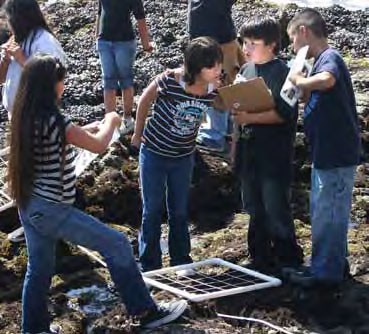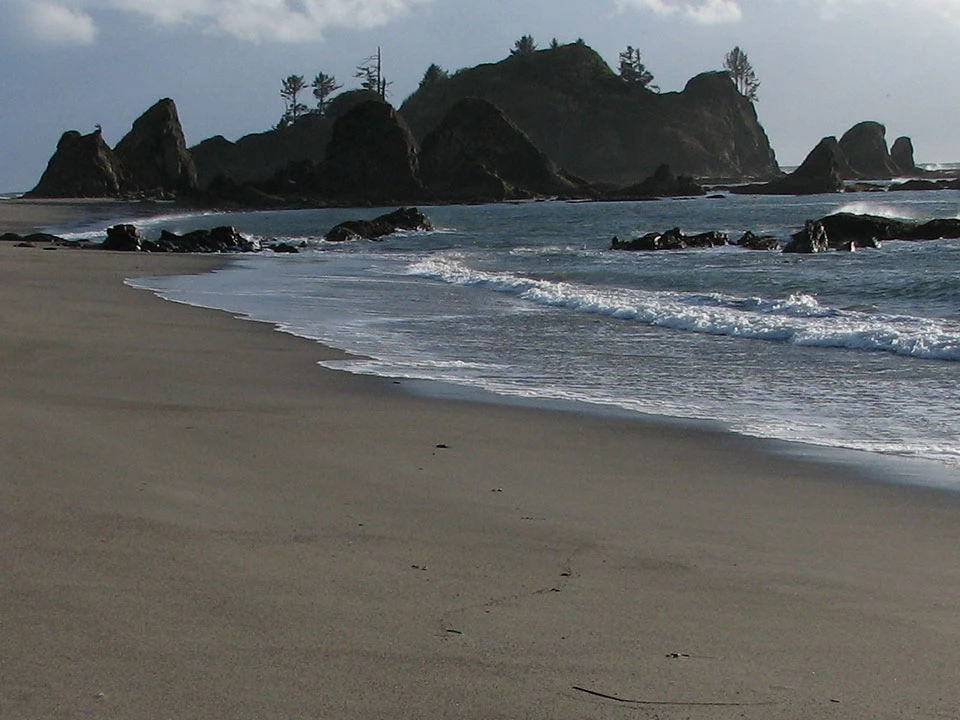Part of a series of articles titled Pacific Ocean Education Team (POET) Newsletters.
Article
POET Newsletter Winter 2009

NOAA
Stewardship Without Boundaries: Conserving Our Ocean Ecosystem from Baja to the Bering Sea
Since the establishment of the first coastal park in 1916, marine resources in the National Park System have grown to include more than three million acres of ocean and 5,000 miles of coast. The Pacific West and Alaska Regions are comprised of 34 diverse coastal park units and 40 sites that are connected to the ocean by watersheds, weather, migration routes and/or trade. Millions of people visit the Pacific Ocean parks to experience our nation's heritage where land meets water and life is entwined with the sea. Rocky coasts, white sand beaches, deep-water fjords, coral reefs, tidewater glaciers, kelp forests, wetlands and tidally influenced estuarine systems support abundant life and contain culturally and historically significant resources. Congress charged the National Park Service with conserving both natural and cultural resources unimpaired for the enjoyment of current and future generations. Their benefits to the nation as places for recreation, sanctuaries for ocean wildlife, and sources of local economic activity are unsurpassed.
In recent years, the Department of Interior and the National Park Service have placed greater emphasis on the management and stewardship of ocean resources. This emphasis addresses the challenges facing our coastal and oceanic systems, including: climate change, development, nutrient runoff, declining water quality, ocean pollution, overfishing and the introduction of invasive species. These challenges threaten to diminish the ecological integrity, beauty, cultural resources, biodiversity and recreational opportunities of our parks throughout the Pacific West and Alaska Regions. Using the vision provided in the Pacific Ocean Park Stewardship Action Plan, the current and future challenges confronting parks will be addressed through the following strategies:
- Establish a seamless network of ocean parks, sanctuaries, refuges and reserves;
- Inventory, map and protect ocean parks;
- Engage visitors in ocean park stewardship; and
- Increase NPS technical capacity for ocean exploration and stewardship.
Through the recognition that the ocean's extent stretches far beyond the boundaries of the National Park Service and coastal waters, the Pacific Ocean Stewardship Action Plan hopes to protect these outstanding resources of all Pacific West and Alaska Region parks for the enjoyment and benefit of future generations.
A Seamless Network of Parks, Sanctuaries, Refuges & Reserves
With so many federal, state and local agencies, and conservation organizations sharing responsibility for protecting marine resources, the idea of a seamless network of parks, sanctuaries, refuges and reserves working together is gaining momentum. In August 2006, an Interagency General Agreement was signed by the National Park Service, National Marine Sanctuary Program, US Fish & Wildlife Service and the National Estuarine Research Reserves. This seamless marine network will result in more effective interagency coordination and operational efficiencies, specifically:
- Increased understanding of marine natural and cultural resources
- Enhanced public awareness and education
- Improved resource protection and rescue capabilities
- Increased effectiveness of resource planning
The Pacific Ocean Parks Strategic Plan outlines specific partner opportunities to enhance marine resource conservation and education. Strategies include establishing Marine Reserves, convening multi-agency workshops, participating in the West Coast Governor’s Oceans Working Group and the Alaska Marine Ecosystem Forum, and studying the feasibility of a Pacific West and Alaska Ocean Center of Excellence. The strategic plan also calls for facilitating international partnerships and building sister park relationships with Canada, Mexico and neighboring Pacific Islands. Working together in a seamless network of protected areas is crucial to the conservation of coral reefs, estuaries, kelp forests, marine mammal habitats, coastal heritage resources and other valuable marine resources.

Life Entwined with the Sea: The Non-Coastal Park Connection
From the Inupiat communities of Cape Krusenstern National Monument to the coral reefs of the National Park of American Samoa, our sites and resources are entwined with the sea. Some park sites may appear divorced from the ocean today, but even they were once teeming with ocean life or are connected to the sea by watersheds, weather, rivers, migration routes or trade.
The geologic bones of many of our inland parks including John Day Fossil Beds National Monument, Death Valley and Great Basin National Parks were created from creatures and plants that once thrived in those ancient oceans. Fossil evidence tells the story of life and changing environments. Without this vast initial maritime deposition for the forces of erosion to work upon, our parks would not exist as we know them today.
The health of our society and national parks are also linked with the sea. Climate change affects on the oceans impacts weather patterns and water availability for all terrestrial life. A clockwise circulation of water, known as the North Pacific Gyre generally dominates the North Pacific and regulates the temperature of the water. This pattern of circulation is comprised of several smaller—but no less important—currents, the Alaskan Current, the Californian Current and the North Equatorial Current which eventually forms the Kuroshio Current (also called the Japan Current). This warm, saline current warms the shores of the western Pacific and generates weather conditions not only for the coastal areas but also far into the interior. Fluctuations in current temperature such as El Niño or La Niña have far ranging effects on weather in the interior of the country such as droughts, severe weather systems, and higher or lower than normal summer and winter temperatures.
As divorced as land bound parks may seem from the ocean by geographical distance, they too have been and are being shaped by ocean processes. As ? once said, "Eventually the ocean consumes everything from feathers to continents, yet…something new is always being born."

Engage Visitors in Ocean Park Stewardship
AK Region parks are a major destination for local, national and international visitors, creating opportunities for a wide variety of experiences. Many of our coastal parks are located near major population centers, thus providing extraordinary venues through which to communicate ocean stewardship messages. At remote parks, the isolation from those population centers gives the visitor opportunities to focus on the surprising connections that inland parks have to the ocean. As human populations expand and ethnic demographics change, pressures on ocean and coastal resources will increase. Knowing the status of watershed, coastal and ocean resources, understanding related climate change topics and expected societal consequences, fostering changes in daily habits that would promote ocean resource conservation, and cultivating innovative thinking on approaches for ocean resource protection, highlight just a few of the messages that will enhance knowledge and awareness of critical marine resource issues. On-site and virtual park visitors, community neighbors, teachers, students, park staff and volunteers are examples of the broad audiences that are reached with a diversity of education and communication techniques.
Communicating a park's connection to the ocean can take many forms. For example, coastal parks have incorporated science and cultural curriculum to conduct marine science camps, which use real world park based examples that teach scientific principles (biology, ecology, geology) relevant to students. Other coastal parks have sponsored or participated in beach clean-ups as part of a broad community program involving many volunteer groups and participated in community programs to educate the public about marine animal and environmental issues. Our non-coastal parks have developed educational and interpretive programs highlighting the ocean connection of salmon with the forests, and watersheds to the Pacific, and the migration of birds and fish from the Pacific Ocean into the Interior. In addition, inland parks have highlighted watershed quality/protection of downstream resources and systems including ocean systems. Both coastal and inland parks have developed programs that link ocean generated weather to glacier formation, water supply, and threats associated with global climate change from the coast to the mountains in the Pacific Northwest.
While embracing the diversity of our PW/AK Region parks we also acknowledge the underlying commonalities including our ocean connections. Borrowing two concepts from the cultural language of our Hawaiian parks, we strive to have malama aina—care of that which feeds us; care of the land ahupua'a - from the mountains to the sea.
Inventory Map & Protect Ocean Parks
The National Park Service has stewardship responsibility for a significant amount of submerged marine area. Resulting from decades of studies, inventories, assessments, and monitoring, our knowledge of natural and cultural resources associated with terrestrial areas of ocean parks is relatively robust. The submerged portions— often a major park component—have not been systematically surveyed and lack this fundamental information. Bathymetry, sediment type, habitat, and species composition/distribution/abundance are basic kinds of information essential for park managers to effectively design resource protection strategies, identify restoration needs, implement resource monitoring, and provide for recreation opportunities. It is also important to inventory, map and protect submerged archeological resources that document the exploration, colonization, and development of commerce in the Pacific Ocean.
Coastal and marine regions are increasingly the subject of active management decisions, but our understanding of how submerged environments and associated biota, historic resources, and archeological resources are responding to climate change, including sea-level rise, changing storm frequencies and intensities, changing salinity and temperature and other issues (e.g., nutrient input, fishing pressure) must be strengthened to support scientifically-informed management decisions. Additionally, mapping ocean parks helps visitors visualize submerged park seascapes and better connect with them.
Ocean Stewardship: A Commitment to Collaboration for Conservation

NPS
The Alaska and Pacific West Regions have a long history of commitment to ocean resource stewardship through active resource assessment, science, protection, education, interpretation and planning programs. This dedication can continue to be enhanced by collaboration with partners, sharing of resources among parks and partners, marine-focused training, maximization of existing capacity and investment in additional personnel, equipment, facilities and support.
Research Learning Centers within our regions have the potential to become centers of regional and national excellence on marine ecosystems and the ocean’s impacts on watersheds, rivers, migration routes and ocean generated weather. They also may serve as facilitators for technical workshops, symposia and training to enhance knowledge of ocean issues.
The Pacific Ocean Parks Strategic Plan: Conserving Our Coastal, Island and Marine Resources offers a call to action for the National Park Service to fulfill its leadership role as an ocean conservation agency. Working with all the communities and partners who share our ocean heritage, the Alaska and Pacific West regions can restore and conserve the grandeur of ocean resources in the National Park System for future generations.
Contributors:
Lynn Aderholt, KEFJ
Yvonne Menard, CHIS
Kristy Sholly, KEFJ
Editors:
Fritz Klasner, KEFJ
Kristy Sholly, KEFJ
Layout/Design:
Nichole Andler, BELA
Tags
- bering land bridge national preserve
- cape krusenstern national monument
- channel islands national park
- death valley national park
- great basin national park
- john day fossil beds national monument
- kenai fjords national park
- national park of american samoa
- olympic national park
- pacific ocean education team
- pacific ocean
- ocean
- stewardship without boundaries
- stewardship
- pacific ocean park stewardship action plan
- pacific ocean stewardship action plan
- pacific ocean parks strategic plan
- cape krusenstern
- cape krusenstern national monument
- national park of american samoa
- john day fossil beds national monument
- death valley
- death valley national park
- great basin
- great basin national park
- channel islands national park
- channel islands
- ocean stewardship
- olympic
- olympic national park
Last updated: December 5, 2022
